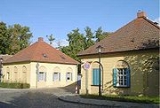
Paretz Palace
Encyclopedia
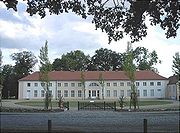
Village
A village is a clustered human settlement or community, larger than a hamlet with the population ranging from a few hundred to a few thousand , Though often located in rural areas, the term urban village is also applied to certain urban neighbourhoods, such as the West Village in Manhattan, New...
in the German
Germany
Germany , officially the Federal Republic of Germany , is a federal parliamentary republic in Europe. The country consists of 16 states while the capital and largest city is Berlin. Germany covers an area of 357,021 km2 and has a largely temperate seasonal climate...
state of Brandenburg
Brandenburg
Brandenburg is one of the sixteen federal-states of Germany. It lies in the east of the country and is one of the new federal states that were re-created in 1990 upon the reunification of the former West Germany and East Germany. The capital is Potsdam...
in the district of Havelland
Havelland
Havelland is a geograhical region and district in Brandenburg, Germany. It is bounded by the districts of Ostprignitz-Ruppin and Oberhavel, the city-state of Berlin, the district of Potsdam-Mittelmark, the city of Brandenburg and the state of Saxony-Anhalt .-History:-Geography:Geographically...
, west of Berlin
Berlin
Berlin is the capital city of Germany and is one of the 16 states of Germany. With a population of 3.45 million people, Berlin is Germany's largest city. It is the second most populous city proper and the seventh most populous urban area in the European Union...
. Recently, a district reform made Paretz into a borough of the city of Ketzin
Ketzin
Ketzin is a town in the Havelland district, in Brandenburg, Germany. It is situated on the river Havel, 17 km northwest of Potsdam, and 40 km west of Berlin.-Geography:...
. It has a population of approximately 400. In the late 18th and early 19th centuries the village was the summer residence King Frederick William III of Prussia
Frederick William III of Prussia
Frederick William III was king of Prussia from 1797 to 1840. He was in personal union the sovereign prince of the Principality of Neuchâtel .-Early life:...
and of his wife Queen Louise
Louise of Mecklenburg-Strelitz
Duchess Louise of Mecklenburg-Strelitz was Queen consort of Prussia as the wife of King Frederick William III...
.
Paretz Palace
The manorial estate of Paretz was originally property of the von Bredow family from whom, in 1677, the Brandenburg diplomat Christoph Caspar von BlumenthalVon Blumenthal
The von Blumenthal family are German nobility from Brandenburg-Prussia. Other, unrelated, families of this name exist in Switzerland and formerly in Russia, and many unrelated families called "Blumenthal" without "von" are to be found worldwide.The family was already noble from earliest times ,...
bought it. It was from here that his daughter Wilhelmina eloped with Ernst Christian von Weiler, a married man, in 1689. The estate was inherited by Count Hans von Blumenthal, former commander of the Gardes du Corps, who in retirement was tutor to the Crown Prince Frederick William (later King Frederick William III of Prussia
Frederick William III of Prussia
Frederick William III was king of Prussia from 1797 to 1840. He was in personal union the sovereign prince of the Principality of Neuchâtel .-Early life:...
).
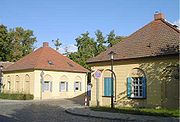
Thaler
The Thaler was a silver coin used throughout Europe for almost four hundred years. Its name lives on in various currencies as the dollar or tolar. Etymologically, "Thaler" is an abbreviation of "Joachimsthaler", a coin type from the city of Joachimsthal in Bohemia, where some of the first such...
s (approximately € 120,000 as of 2005). The Berlin architect David Gilly
David Gilly
David Gilly was a German architect and architecture-tutor in Prussia, the father of the architect Friedrich Gilly.-Life:...
was put in charge of the construction of the building and it was planned to become a country palace. "Just remember always that you are building for a poor farmer", the crown prince is said to have told the architect. Flanking the palace were placed two barn buildings each, on the left and right, (one on each side to house animals) thus forming a semi circular yard. In 1804 the royal couple had the entire village rebuilt to conform to David Gilly's designs but the uniform style is hardly recognizable anymore today.
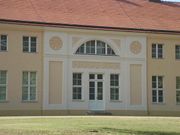
Frederick William IV of Prussia
|align=right|Upon his accession, he toned down the reactionary policies enacted by his father, easing press censorship and promising to enact a constitution at some point, but he refused to enact a popular legislative assembly, preferring to work with the aristocracy through "united committees" of...
had the wallpaper and furniture replaced in several rooms. The appeal of the Schloss-Still-im-Land was lost however and the palace remained untouched and empty until early in the 20th century.
The palace continued to be owned by the Hohenzollern until 1945: King Frederick William IV had passed the palace on to King Wilhelm I who became Emperor of Germany in 1871. In 1888 Prince Heinrich took over the palace and his wife Princess Irene of Hesse and the Rhine continued after his death in 1929.
In April 1945 the Red Army
Red Army
The Workers' and Peasants' Red Army started out as the Soviet Union's revolutionary communist combat groups during the Russian Civil War of 1918-1922. It grew into the national army of the Soviet Union. By the 1930s the Red Army was among the largest armies in history.The "Red Army" name refers to...
took possession of the grounds and the troops didn't leave until halfway through 1946. A year later, refugee
Refugee
A refugee is a person who outside her country of origin or habitual residence because she has suffered persecution on account of race, religion, nationality, political opinion, or because she is a member of a persecuted 'social group'. Such a person may be referred to as an 'asylum seeker' until...
s moved into the buildings and in 1948 ownership of the palace was transferred to the Zentrale Verwaltung der gegenseitigen Bauernhilfe (ZVdgB) ("Central Administration of Mutual Aid to Farmers"). Modifications to the complex through 1950 completely changed the look of the palace and farm.
Special attractions of the palace are the tapestries that are adorned with exotic plant motives, bird renditions and depictions of landscapes in the Potsdam
Potsdam
Potsdam is the capital city of the German federal state of Brandenburg and part of the Berlin/Brandenburg Metropolitan Region. It is situated on the River Havel, southwest of Berlin city centre....
area. The tapestries survived World War II
World War II
World War II, or the Second World War , was a global conflict lasting from 1939 to 1945, involving most of the world's nations—including all of the great powers—eventually forming two opposing military alliances: the Allies and the Axis...
as they had been removed and kept in the New Palace
New Palace
New Palace can refer to:* The former name of Topkapı Palace in Istanbul after its completion * New Palace...
in Potsdam for safe keeping.
Gothic House
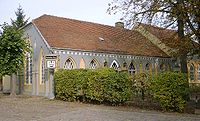
Gothic architecture
Gothic architecture is a style of architecture that flourished during the high and late medieval period. It evolved from Romanesque architecture and was succeeded by Renaissance architecture....
House is a former royal forge
Forge
A forge is a hearth used for forging. The term "forge" can also refer to the workplace of a smith or a blacksmith, although the term smithy is then more commonly used.The basic smithy contains a forge, also known as a hearth, for heating metals...
. It is notable as the only neo-Gothic structure among the other rather simple buildings. Currently, a restaurant is being operated in the building.
Paretzer Erdlöcher
During the 19th century the production of brickBrick
A brick is a block of ceramic material used in masonry construction, usually laid using various kinds of mortar. It has been regarded as one of the longest lasting and strongest building materials used throughout history.-History:...
s was an important industry for the area as they could be sold to the ever growing city of Berlin. Therefore, many villages had several tile producing companies. To make the bricks, clay was needed and mined from the clay ground common to the area.
When the business slowed down after World War I, the clay mines filled with ground water and turned into small lakes, the Erdlöcher or "holes in the ground". After World War II, some holes were backfilled with rubble from bombed Berlin (in a peculiar kind of material cycle), today most of them however are home to numerous water fowl and have been placed under environmental protection.
Theodor Fontane
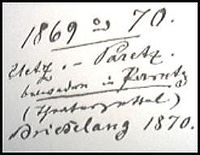
Theodor Fontane
Theodor Fontane was a German novelist and poet, regarded by many as the most important 19th-century German-language realist writer.-Youth:Fontane was born in Neuruppin into a Huguenot family. At the age of sixteen he was apprenticed to an apothecary, his father's profession. He became an...
liked the village a lot and come to visit Paretz three times: in the spring of 1861, 1869 and in May 1870. He describes the farm Paretz in his Wanderungen durch die Mark Brandenburg in vivid colors:
- "Uetz and Paretz are separated by little more than half a mile. On a summer afternoon this is an inspiring walk. The path leads through the meadows and the smell of hay is present from the fields all around us. A thin, fog lit by the sun marks the spot where the wide Havel with its many bays and lakes lies. Paretz itself does not appear to us until the very last."
- "Finally the path turns into a levee and instead of the fruit trees that so far have kept us company there are tall poplarPoplarPopulus is a genus of 25–35 species of deciduous flowering plants in the family Salicaceae, native to most of the Northern Hemisphere. English names variously applied to different species include poplar , aspen, and cottonwood....
s and royal buildings everywhere until we cross a light and elegant bridge, called the Infantenbrücke, and reach the village road. The road takes us through the park then grows wider just after going around a bend and we are there."
Waterways
Paretz lies on the River HavelHavel
The Havel is a river in north-eastern Germany, flowing through the German states of Mecklenburg-Vorpommern, Brandenburg, Berlin and Saxony-Anhalt. It is a right tributary of the Elbe river and in length...
between the cities of Potsdam
Potsdam
Potsdam is the capital city of the German federal state of Brandenburg and part of the Berlin/Brandenburg Metropolitan Region. It is situated on the River Havel, southwest of Berlin city centre....
and Brandenburg
Brandenburg
Brandenburg is one of the sixteen federal-states of Germany. It lies in the east of the country and is one of the new federal states that were re-created in 1990 upon the reunification of the former West Germany and East Germany. The capital is Potsdam...
, and the junction of that river with two canals is nearby. Both canals were built to provide alternative routes to the river, but for rather different ulterior purposes.
In the 1870s, the Sacrow–Paretz Canal
Sacrow–Paretz Canal
The Sacrow–Paretz Canal, or Sacrow-Paretzer-Kanal in German, is a canal in the German state of Brandenburg. It provides a short cut for vessels navigating the River Havel, linking the Jungfernsee, near Potsdam, with Paretz....
was constructed to link Paretz with the Jungfernsee
Jungfernsee
The Jungfernsee is located north of Potsdam, Germany. It was a glacial kettle and is now part of the River Havel, which runs along its southeastern shore, which is also the only part of its shores that is in Berlin...
, near Potsdam
Potsdam
Potsdam is the capital city of the German federal state of Brandenburg and part of the Berlin/Brandenburg Metropolitan Region. It is situated on the River Havel, southwest of Berlin city centre....
, thus providing a shorter navigation route to Berlin
Berlin
Berlin is the capital city of Germany and is one of the 16 states of Germany. With a population of 3.45 million people, Berlin is Germany's largest city. It is the second most populous city proper and the seventh most populous urban area in the European Union...
and points upstream for vessels navigating the River Havel. In the 1950s, the Havel Canal
Havel Canal
The Havel Canal, or Havelkanal in German, is a canal in the German state of Brandenburg. It provides an alternate route to the River Havel, between Hennigsdorf and Paretz, thus avoiding a passage through the waterways of Berlin between Spandau and Potsdam.Construction of the canal was authorised by...
was constructed to link Paretz with Hennigsdorf
Hennigsdorf
Hennigsdorf is a town in the district of Oberhavel, in Brandenburg, Germany. It is situated north-west of Berlin, just across the city border, which is formed mainly by the Havel river.-History:...
, significantly further upstream than Potsdam and avoiding a passage through the reach of the River Havel that was under the political control of West Berlin
West Berlin
West Berlin was a political exclave that existed between 1949 and 1990. It comprised the western regions of Berlin, which were bordered by East Berlin and parts of East Germany. West Berlin consisted of the American, British, and French occupation sectors, which had been established in 1945...
. Both canals are still in use, providing shorter routes for shipping from the west to Berlin and to the Oder–Havel Canal and Poland
Poland
Poland , officially the Republic of Poland , is a country in Central Europe bordered by Germany to the west; the Czech Republic and Slovakia to the south; Ukraine, Belarus and Lithuania to the east; and the Baltic Sea and Kaliningrad Oblast, a Russian exclave, to the north...
.

